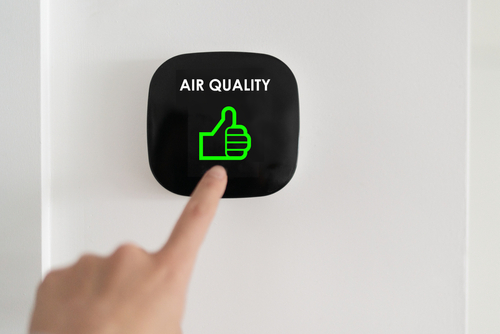Facility managers play an important role in ensuring indoor air quality (IAQ). The direct and indirect impacts of IAQ are well understood, particularly for those who suffer from lung or heart conditions. The U.K.’s National Health Service (NHS) has estimated that poor IAQ may cost the country up to £20 billion (~$24 billion) annually and is the cause of 24,000 people dying prematurely every year.

Increasingly, energy efficiency is also an important aspect of the facility manager’s purview—and with good reason since buildings alone account for nearly 40% of energy consumption worldwide. The U.S. Environmental Protection Agency (EPA) has validated the various benefits of energy efficiency, including the environmental (e.g., reducing greenhouse gases) and the economic (e.g., lower utility costs) benefits.
Is there a correlation between IAQ and energy efficiency for industrial and commercial facilities? Is there any truth to assertions that energy efficiency measures can negatively impact the quality of air indoors? Can the two be mutually beneficial?
This article will delve into these questions, providing insights into how IAQ and energy efficiency can indeed co-exist to benefit health and the environment.
IAQ and Energy Efficiency—A Bad Match?
At first glance, IAQ and energy efficiency appear unrelated. After all, IAQ is an occupational health factor, while energy efficiency is an environmental impetus—they are not innately compatible.
Of course, the health benefits of having less air pollution and more clean water are considered self-evident. Is there a similar correlation between IAQ and the more efficient use of energy in buildings? There is a contention by some experts that, in the absence of mechanical ventilation, energy efficiency measures can inhibit IAQ since the infiltration of air is minimal, thereby lowering IAQ levels in a building or residence.
Does a push for greater energy efficiency compromise IAQ? Well, it might. A 2022 Swedish study by Wang, Wang & Norbäck confirmed that energy-saving measures in so-called “airtight buildings” in the absence of mechanical ventilation can impair IAQ in buildings.
Furthermore, the study found that energy efficiency retrofits can increase indoor radon, which can contribute to lung cancer. Energy efficiency can also increase the levels of hazardous chemicals such as benzene, toluene, ethyl benzene, and xylene (BTEX) indoors. The Swedish researchers concluded that these adverse impacts caused by retrofits could be mitigated by installing mechanical ventilation.
IAQ and Energy Efficiency Can Be Compatible
The good news is that there is a slew of practical examples of solutions that enable both energy efficiency and good levels of IAQ—these include high-efficiency filtration and energy recovery systems.
The aforementioned Swedish study cited a host of other studies regarding energy efficiency and IAQ conducted in the United States, Canada, and India. They demonstrated that green (i.e., energy-efficient) buildings can reduce asthma, non-asthmatic respiratory symptoms, and improve workers’…
- general health,
- mental health,
- performance, and
- satisfaction.
Smart HVAC solutions in particular can result in much-improved IAQ and energy usage rates. This issue came to a head as a result of COVID-19, when HVAC-focused infection mitigation strategies gained huge popularity.
The focus revolved far more around increased ventilation, filter efficiency, and ultraviolet energy, in order to either dilute or filter out pathogens. An example is a combination of medium-efficiency filters with ultraviolet germicidal irradiation, which guarantee clean air without sacrificing airflow or cooling capacity. Resorting to these types of filtration systems also has the benefit of reducing HVAC energy consumption.
Smarter Buildings Are Both Healthy and Green
Green imperatives that are inherent in smart buildings not only improve energy efficiency, but also result in buildings that are well ventilated and, therefore, possess improved IAQ. The previous section highlighted the benefits of an improved HVAC system to both IAQ and energy efficiency—smart buildings can take HVAC systems to the next level, thanks to the Internet of Things (IoT).
Advanced IoT solutions can enable a network of interconnected HVAC-related technologies, including motion and noise detectors, humidity sensors, thermometers, and location indicators, among others. Embedded artificial intelligence (AI) and machine learning (ML) can trigger automated changes to the HVAC system based on readings, making adjustments as needed.
Furthermore, smart buildings also incorporate smart systems, which in turn positively impact energy efficiency and air quality. As reported in Forbes, Brian Turner, the CEO of Buildings IOT, has noted how the evolution of IoT means that sensors are far more intelligent.
Not only do smart HVAC systems ensure better IAQ and energy efficiency, they do so based on fluctuating occupancy levels and area usage rates. The result, according to Turner, is far more precise usage of ventilation, heating, and cooling—all of which improve IAQ levels and energy consumption.
Green and Healthy Maintenance
As with smart HVAC systems, smarter maintenance also makes a difference. Appropriate maintenance of machinery and equipment should ensure cleaner indoor air and better energy usage.
Significant IAQ improvements are especially welcome when one considers that indoor air is typically two to five times more polluted than the air outdoors, according to the EPA. The same agency advises that commercial and industrial facilities should undertake a professional energy audit in order to implement energy-saving measures that do not adversely affect IAQ.
Maintenance is not only about the optimization of physical assets in an effort to ensure productivity and reduce costs. Poor or compromised maintenance can result in a slew of hidden maintenance costs, including higher energy costs and health risks:

The facility management function has increased immensely in scope in recent years—going far beyond maintaining assets and buildings in good condition. Climate change fears have increased the need for efficient energy consumption. COVID-19 has heightened the importance of IAQ, too. Thankfully, using smart technology and systems, the facility manager can ensure that both these imperatives are met and remain compatible.
Bryan Christiansen is the founder and CEO of Limble CMMS. Limble is a modern, easy-to-use mobile CMMS software that takes the stress and chaos out of maintenance by helping managers organize, automate, and streamline their maintenance operations.
